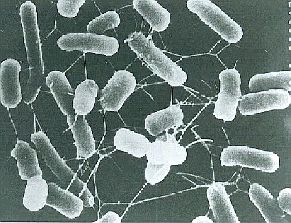Tokyo Food Safety Information Center » Good things to know » The microorganisms which cause food poisoning » Enterohemorrhagic E. coli O157
Enterohemorrhagic E. coli O157
Characteristics

E. coli lives in the digestive tracts of people and animals and, under normal circumstances, does not cause illness. However, several varieties of diarrheagenic E. coli cause sickness in humans; collectively, they are known as diarrheagenic E. coli (also called pathogenic E. coli).
Enterohemorrhagic E. coli O157 is one member of the diarrheagenic E. coli group and was a significant problem across Japan in 1996.
E. coli O157 can produce verotoxin VT1 and VT2 (or one of either), which cause hemorrhagic colitis. Many healthy people present no particular symptoms when infected with O157 and may only experience some diarrhea before overcoming the disease.
In infants, young children, and elderly people with other underlying health conditions, however, E. coli O157 can cause stomach pain, bloody stool, and hemorrhagic enteritis. In rare cases, it can also cause hemolytic-uremic syndrome (HUS), a collection of symptoms including acute renal failure, decreased blood platelets, and anemia.
Which foods can cause E. coli O157 infection?
Enterohemorrhagic E. coli O157 may be carried by cattle and other livestock and secondary contamination caused by meat contaminated by the feces of the same can result in food poisoning from any number of foods. Past examples include beef, processed beef products, salads, pickled bok choy, and well water.
What are the symptoms of E. coli O157 infection?
E. coli O157 has an incubation period of 4 to 8 days, after which symptoms commonly start with intense stomach pain followed several hours later by watery diarrhea. Bloody diarrhea may follow 1 to 2 days later. Bloody diarrhea caused by O157 is almost entirely blood, containing no fecal matter. O157 can also be complicated by hemolytic-uremic syndrome (HUS) and encephalopathy. HUS is characterized by symptoms such as hemolytic anemia, decreased blood platelets, and acute renal failure caused by the destruction of red blood cells approximately one week after the onset of diarrhea. In serious cases HUS can result in death.
What are the key points to preventing E. coli O157 infection?
- Thoroughly wash vegetables and other foods and cook meat thoroughly to ensure the penetration of heat to its center before eating.
- Frequently inspect foods stored in your refrigerator and eat them as early as possible after purchase.
- Be sure to always thoroughly wash cooking implements to prevent secondary contamination of cooked foods. If possible, sterilize cooking implements with boiling water or chlorine-based disinfectants.
- Always wash your hands with soap prior to preparing food and before eating.
- When drinking or cooking with water other than that received directly from a tap, be sure to have its quality tested at least once a year to check whether it is still safe to consume.
- Periodically clean and conduct inspections of building water tanks, etc.
- If you experience stomach pain and continued diarrhea, seek diagnosis from your family physician as soon as possible.
- If a family member becomes infected, take particular care in handling items such as underwear contaminated with fecal matter.